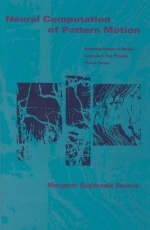
Neural Computation of Pattern Motion
MIT Press (Verlag)
978-0-262-19329-0 (ISBN)
- Titel ist leider vergriffen;
keine Neuauflage - Artikel merken
How does the visual system compute the global motion of an object from local views of its contours? Although this important problem in computational vision (also called the aperture problem) is key to understanding how biological systems work, there has been surprisingly little neurobiologically plausible work done on it. This book describes a neurally based model, implemented as a connectionist network, of how the aperture problem is solved. It provides a structural account of the model's performance on a number of tasks and demonstrates that the details of implementation influence the nature of the computation as well as predict perceptual effects that are unique to the model. The basic approach described can be extended to a number of different sensory computations.Sereno first reviews current research and theories about motion detection. She then considers the formal aspects of the aperture problem and describes a model of pattern motion perception that stands out in several respects.
The model takes into account the structure of the visual system and attempts to build on known neurophysiological structures that might be available for solving the aperture problem, comparing performances in tasks involving direction and speed acuity, transparency, and motion coherency to human performance. The model's emphasis on the details of implementation rather-than on the goals of computation show that the details of data representation change the nature of the computation, producing predictions (including several illusions) that are unique and that can be confirmed through psychophysical experiments.Margaret Euphrasia Sereno is Assistant Professor of Psychology at the University of Oregon.
Series Foreword Acknowledgements I Introduction 1.1 Background 1.2. The Approach 2 Computational , psychophysical, and Neurobiological Approaches to Motion Measurement 2.1 Introduction 2.2 computational Models 2.3 Psychophysics Review 2.4 Neurobiology Review 2.5 Summary 3 The Model 3.1 Theoretical Background 3.2 Structure 3.3 Linear Associator 3.4. Performance Measures 4 Simulation Results 4.1 Training Set and Network Structure 4.2 Weight Structures after Training 4.3 Performance as a Function of the Number of input Locations 4.4. Performance of Average/prototype Weight Matrices 4.5 Speed Psychophysics 4.6 Multiple Moving Objects 4.7 Motion Coherency 4.8 Plaid Angle Simulation 4.9 Plaid Angle Psychophysics 5 Psychophysical Demonstrations 5.1 Split-Herringbone Illusions for Rotation and Dilation 5.2 Nulling the Perceived Size Change of Rotating Spirals and the Perceived Nonrigidity of Rotating Ellipses 6 Summary and Conclusions 6.1 Structural Account of Model's Performance 6.2 Network Approach Contrasted with Other Approaches 6.3 Future Directions. Appendix Aperture Problem Linearity A.1 Analytic Solutions to the Aperture Problem A.2 Linear and Nonlinear Aspects of the Aperture Problem.
| Erscheint lt. Verlag | 4.5.1993 |
|---|---|
| Zusatzinfo | 41 |
| Verlagsort | Cambridge, Mass. |
| Sprache | englisch |
| Maße | 152 x 229 mm |
| Gewicht | 431 g |
| Themenwelt | Geisteswissenschaften ► Psychologie |
| Medizin / Pharmazie ► Medizinische Fachgebiete ► Neurologie | |
| Naturwissenschaften ► Biologie ► Zoologie | |
| ISBN-10 | 0-262-19329-9 / 0262193299 |
| ISBN-13 | 978-0-262-19329-0 / 9780262193290 |
| Zustand | Neuware |
| Haben Sie eine Frage zum Produkt? |
aus dem Bereich


